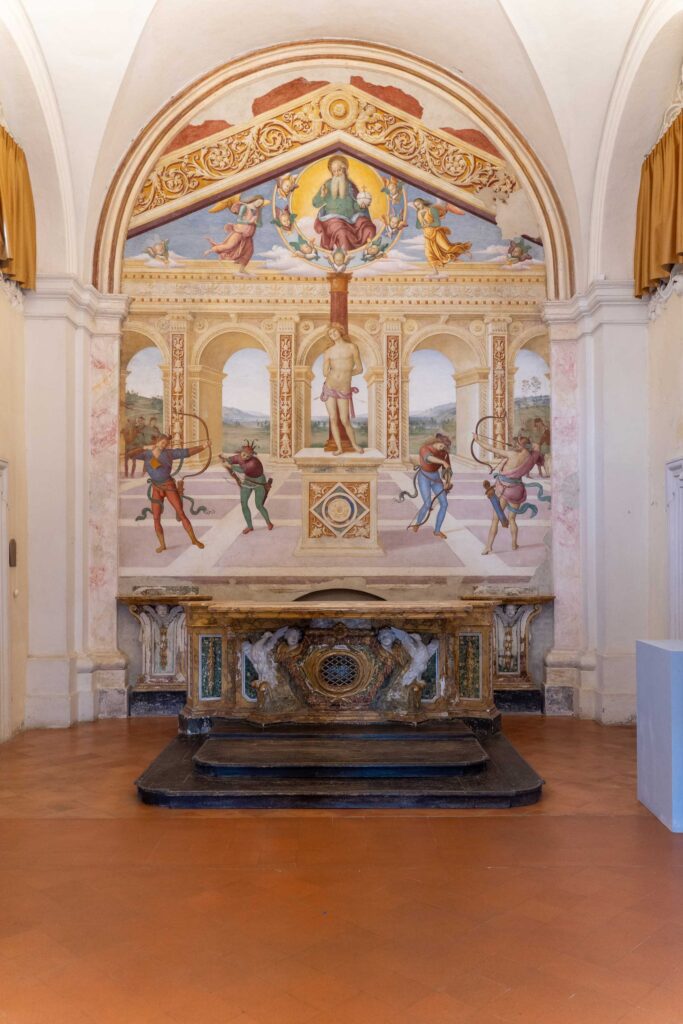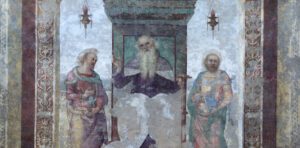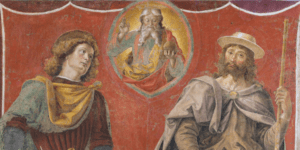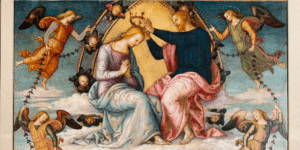The Martyrdom of Saint Sebastian: A fresco by Perugino in Panicale
Perugino painted The Martyrdom of Saint Sebastian in 1505. The fresco is located inside Saint Sebastian’s Church in Panicale, a small town in Umbria, not far from Lake Trasimeno; and is the sole work by Perugino there.
A soldier, then a martyr for Christian faith
Sebastian was a Christian saint who lived in the third-fourth century AD when the Roman Empire was ruled by Diocletian. According to Saint Ambrose, Sebastian was born in Milan, where he successfully took up the military career, so much so that he was esteemed by two emperors, Maximian and Diocletian himself. During his service in the army he would discover Christian faith; he therefore strove to convert the people and make them believers, comfort those who had been imprisoned, and bury those who had been martyred. When all these pious actions were detected, he was sentenced to death.

His martyrdom as depicted by Perugino
Perugino shows the first try at martyring Sebastian – he would anyway survive after having been nursed by a woman. The scene takes place in an idealized city setting, built in a perfectly geometrical perspective.
In the middle, on a floor in the open air paved with pink squares, there rises a pedestal upon which Saint Sebastian stands, bound to a pillar, naked, and pierced by two arrows. His body recalls a classical Greek statue while his countenance expresses a resigned attitude, that of a Christian martyr who sacrifices his life for the sake of faith in God.
Thee archers and a crossbowman, divided in two groups of two, appear on the right and on the left of the pedestal on which the Saint’s feet rest. Their rhythmical movements make us think of dancers, rather than persecutors. But, however unnatural their poses may seem, they were carefully studied by Perugino.
The perspective leads the observers’ eyes toward an architectural structure with five arches (it delimits the square) and a vast landscape in the background, that can be made out behind the arches. Perugino used to pay much attention to natural elements – trees, water, hills, mountains – which he rendered by employing atmospheric perspective. By means of this technique, the artist tries to imitate reality accurately, this is why the decrease of colors and light in the long distance makes the mountains look violet or blue.
God the Father blessing
In the upper part of the fresco, Perugino depicted God the Father within a sphere of light as He imparts the blessing. God is encircled by angels, classical-like figures for whose creation the artist probably reused cartoons he had prepared for some previous job.
Harmony and balance in depicting a tragedy
The historical fact of Saint Sebastian’s martyrdom was something tragic and violent, as it was about a man being executed. Perugino however succeeded in rendering it in a placid mood thanks to many elements that drew on Classical Art.
As mentioned above, the Saint’s body recalls the old Greek statues. The arches in ancient Roman style that rise in the background echo the typical structure of a triumphal arch, which Perugino used many times, and was quite fashionable in Renaissance art in general. A frame decorated with vegetable motifs, above the arches, divides the fresco into two different scenes; it reminds us of the design of an ancient temple, the blessing God functioning here as the decoration on a pediment.
And finally, the accurate perspective and the delicate colors – together with the hints at classical art – help in giving a feeling of harmony and balance to all the elements in the fresco.
The artist’s signature
Both the author of the fresco and the year in which it was made are certain since Perugino’s name and the date (in Roman numerals) are reported in the decorations on the pedestal frame in the middle of the composition.









